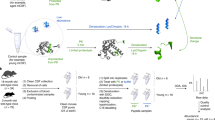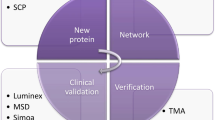Abstract
Two-dimensional gel electrophoresis (2-D GE) is a key tool for comparative proteomics research. With its ability to separate complex protein mixtures with high resolution, 2-D GE is a technique commonly employed for protein profiling studies. Significant improvements have been made in 2-D GE technology with the development of two-dimensional fluorescence difference gel electrophoresis (2-D DIGE), where proteins are first labelled with one of three spectrally resolvable fluorescent cyanine dyes before being separated over first and second dimensions according to their charge and size, respectively. When used in conjunction with automated analysis packages, this multiplexing approach can accurately and reproducibly quantify protein expression for control and experimental groups. Differentially expressed proteins can be subsequently identified by mass spectrometric methods. Here, we describe the successful application and optimisation of 2-D DIGE technology for human postmortem brain studies. This technology, especially when coupled with other functional genomics approaches, such as transcriptomics and metabolomics studies, will enhance our current understanding of human disease and lead to new therapeutic and diagnostic possibilities.
This is a preview of subscription content, access via your institution
Access options
Subscribe to this journal
Receive 12 print issues and online access
$259.00 per year
only $21.58 per issue
Buy this article
- Purchase on Springer Link
- Instant access to full article PDF
Prices may be subject to local taxes which are calculated during checkout










Similar content being viewed by others
References
O'Farrell PH . High resolution two-dimensional electrophoresis of proteins. J Biol Chem 1975; 250: 4007–4021.
Unlu M, Morgan ME, Minden JS . Difference gel electrophoresis: a single gel method for detecting changes in protein extracts. Electrophoresis 1997; 18: 2071–2077.
Lilley KS, Razzaq A, Dupree P . Two-dimensional gel electrophoresis: recent advances in sample preparation, detection, quantitation. Curr Opin Chem Biol 2002; 6: 46–50.
Alban A et al. A novel experimental design for comparative two-dimensional gel analysis: two-dimensional difference gel electrophoresis incorporating a pooled internal standard. Proteomics 2003; 3: 36–44.
Ryan MM et al. Application and optimization of microarray technologies for human post-mortem brain studies. Biol Psych 2004. (in press).
Santoni V, Kieffer S, Desclaux D, Masson F, Rabilloud T . Membrane proteomics: use of additive main effects with multiplicative interaction model to classify plasma membrane proteins according to their solubility, electrophoretic properties. Electrophoresis 2000; 21: 3329–3344.
Gorg A, Postel W, Domscheit A, Gunther S . Two-dimensional electrophoresis with immobilized pH gradients of leaf proteins from barley (Hordeum vulgare): method, reproducibility and genetic aspects. Electrophoresis 1988; 9: 681–692.
Tonge R et al. Validation and development of fluorescence two-dimensional differential gel electrophoresis proteomics technology. Proteomics 2001; 1: 377–396.
Von Eggeling F et al. Fluorescent dual colour 2D-protein gel electrophoresis for rapid detection of differences in protein pattern with standard image analysis software. Int J Mol Med 2001; 8: 373–377.
Zhou G et al. 2D differential in-gel electrophoresis for the identification of esophageal scans cell cancer-specific protein markers. Mol Cell Proteomics 2002; 1: 117–124.
Van Den Bergh G, Clerens S, Vandesande F, Arckens L . Reversed-phase high-performance liquid chromatography prefractionation prior to two-dimensional difference gel electrophoresis and mass spectrometry identifies new differentially expressed proteins between striate cortex of kitten and adult cat. Electrophoresis 2003; 24: 1471–1481.
Gade D, Thiermann J, Markowsky D, Rabus R . Evaluation of two-dimensional difference gel electrophoresis for protein profiling. Soluble proteins of the marine bacterium Pirellula sp. strain 1. J Mol Microbiol Biotechnol 2003; 5: 240–251.
Patton WF . A thousand points of light: the application of fluorescence detection technologies to two-dimensional gel electrophoresis, proteomics. Electrophoresis 2000; 21: 1123–1144.
Karas M, Hillenkamp F . Laser desorption ionization of proteins with molecular masses exceeding 10,000 daltons. Anal Chem 1988; 60: 2299–2301.
Fenn JB, Mann M, Meng CK, Wong SF, Whitehouse CM . Electrospray ionization for mass spectrometry of large biomolecules. Science 1989; 246: 64–71.
Mann M, Wilm M . Error-tolerant identification of peptides in sequence databases by peptide sequence tags. Anal Chem 1994; 66: 4390–4399.
Callahan LM, Selski DJ, Martzen MR, Cheetham JE, Coleman PD . Preliminary evidence: decreased GAP-43 message in tangle-bearing neurons relative to adjacent tangle-free neurons in Alzheimer's disease parahippocampal gyrus. Neurobiol Aging 1994; 15: 381–386.
Henzel WJ et al. Identifying proteins from two-dimensional gels by molecular mass searching of peptide fragments in protein sequence databases. Proc Natl Acad Sci USA 1993; 90: 5011–5015.
Mann M, Hojrup P, Roepstorff P . Use of mass spectrometric molecular weight information to identify proteins in sequence databases. Biol Mass Spectrom 1993; 22: 338–345.
Pappin DJC, Hojrup P, Bleasby AJ . Rapid identification of proteins by peptide mass fingerprinting. Curr Biol 1993; 3: 327–332.
Yates III JR, Speicher S, Griffin PR, Hunkapiller T . Peptide mass maps: a highly informative approach to protein identification. Anal Biochem 1993; 214: 397–408.
Gygi SP et al. Quantitative analysis of complex protein mixtures using isotope-coded affinity tags. Nat Biotechnol 1999; 17: 994–999.
Krapfenbauer K, Fountoulakis M, Lubec G . A rat brain protein expression map including cytosolic, enriched mitochondrial, microsomal fractions. Electrophoresis 2003; 24: 1847–1870.
von Horsten HH . An agarose gel subfractionation technique for the recovery of low-abundance proteins. Anal Biochem 2003; 316: 139–141.
Butt A et al. Chromatographic separations as a prelude to two-dimensional electrophoresis in proteomics analysis. Proteomics 2001; 1: 42–53.
Hanson BJ, Schulenberg B, Patton WF, Capaldi RA . A novel subfractionation approach for mitochondrial proteins: a three-dimensional mitochondrial proteome map. Electrophoresis 2001; 22: 950–959.
Gorg A et al. Sample prefractionation with Sephadex isoelectric focusing prior to narrow pH range two-dimensional gels. Proteomics 2002; 2: 1652–1657.
Hoving S, Voshol H, van Oostrum J . Towards high performance two-dimensional gel electrophoresis using ultrazoom gels. Electrophoresis 2000; 21: 2617–2621.
Shaw J et al. Evaluation of saturation labelling two-dimensional difference gel electrophoresis fluorescent dyes. Proteomics 2003; 3: 1181–1195.
Yan JX et al. Fluorescence two-dimensional difference gel electrophoresis, mass spectrometry based proteomic analysis of Escherichia coli. Proteomics 2002; 2: 1682–1698.
Ruepp SU, Tonge RP, Shaw J, Wallis N, Pognan F . Genomics, proteomics analysis of acetaminophen toxicity in mouse liver. Toxicol Sci 2002; 65: 135–150.
Lee JR et al. Differential protein analysis of spasomolytic polypeptide expressing metaplasia using laser capture microdissection, two-dimensional difference gel electrophoresis. Appl Immunohistochem Mol Morphol 2003; 11: 188–193.
Gharbi S et al. Evaluation of two-dimensional differential gel electrophoresis for proteomic expression analysis of a model breast cancer cell system. Mol Cell Proteomics 2002; 1: 91–98.
Van den Bergh G, Clerens S, Cnops L, Vandesande F, Arckens L . Fluorescent two-dimensional difference gel electrophoresis, mass spectrometry identify age-related protein expression differences for the primary visual cortex of kitten, adult cat. J Neurochem 2003; 85: 193–205.
Acknowledgements
This research was supported by the Stanley Medical Research Institute (SMRI) and the donations of the Stanley brain collection courtesy of Drs Michael B Knable, E Fuller Torrey, Maree J Webster, Serge Weis and Robert H. Yolken. The Department of Psychiatry gratefully acknowledges SMRI centre support. Thanks to all other members of the Bahn laboratory for intellectual and practical input. Sudhakaran Prabakaran is supported through a Nehru and Cambridge Commonwealth Trust scholarship and Janie Swatton is a Community Fund/Alzheimer Research Trust fellow. Kathryn Lilley and Natasha Karp acknowledge support from the BBSRC Investigating Gene Function Initiative.
Author information
Authors and Affiliations
Corresponding authors
Rights and permissions
About this article
Cite this article
Swatton, J., Prabakaran, S., Karp, N. et al. Protein profiling of human postmortem brain using 2-dimensional fluorescence difference gel electrophoresis (2-D DIGE). Mol Psychiatry 9, 128–143 (2004). https://doi.org/10.1038/sj.mp.4001475
Received:
Accepted:
Published:
Issue Date:
DOI: https://doi.org/10.1038/sj.mp.4001475
Keywords
This article is cited by
-
ITRAQ-based quantitative proteomics reveals the proteome profiles of MDBK cells infected with bovine viral diarrhea virus
Virology Journal (2021)
-
The application of omics technologies in the functional evaluation of inulin and inulin-containing prebiotics dietary supplementation
Nutrition & Diabetes (2015)
-
Proteomics identifies differentially expressed proteins in neonatal murine thymus compared with adults
Proteome Science (2012)
-
Quantitative proteomics: assessing the spectrum of in-gel protein detection methods
Journal of Chemical Biology (2011)
-
Myelin Proteomics: Molecular Anatomy of an Insulating Sheath
Molecular Neurobiology (2009)



